Abstract
Taiwan has cultured milkfish for longer than hundreds of years. Given its long and narrow terrain surrounded by sea and location in a subtropical monsoon area, it has developed a unique culture bounded by the Erren River in the south. The Yunjianan area in the north is cold in winter and thus follows the “current year harvest” culturing model. In contrast, the Gaoping area in the south is warmer in winter and follows the “overwinter harvest” culturing model. This paper evaluated the production efficiency by using the stochastic metafrontier production model and the multi-input-multi-output distance function using input from in-person interviews with 100 current year harvest farmers and 70 overwinter harvest farmers from 2017 to 2019. In the first stage, the environmental variables of various regions were internalized into the model to obtain the group technical efficiency (GTE) of different farming models. In the second stage, the common environmental variables were re-internalized to evaluate the metafrontier technical efficiency (MTE) of both culturing modes. In this way, the technical efficiency and production technology of the two different culturing model are reasonably evaluated by taking into account not only the difference between their input and output, but also their environmental difference during their farming periods. The results show that in spite of the environmental difference between th two culturing models, shallower pond, smaller size of fish fry and lower shrimp density should make culturing more technically efficient. When cultured in a common environment, the lower the temperature, the worse the culture efficiency is. It indicated that milkfish are highly sensitive to low temperature. Therefore, the MTE and technical gap rate (TGR) of current year harvest farming are significantly higher than those of overwinter harvest farming. Finally, the regression analysis showed that the younger the farmers were, the lower the average pond age was, the larger the freshwater culture area was, and the greater the experience in fish farming was. Thus, the relatively better the MTE is; the younger the farmers, the higher the education level is and the more years of experience in fish farming they have, thus the relatively better the production technology level is.
1. Introduction
As early as approximately 1600 A.D., there was milkfish (Chanos chanos) (Figure 1) farming in Taiwan. Till now, milkfish is still a traditional food for Taiwanese. It is cheap and nutritious. In the early stage, Taiwan’s milkfish farming mainly adopted the monoculture method. Later, it was found that a mixed culture with white shrimp (Penaeus indicus) (Figure 2) could not only increase owner’s income [1,2,3,4], but also keep fish ponds clean [4,5,6]. However, the cultivation of white shrimp comes with many advantages, such as removing the need for extra feed and cleaning feed residues and fish waste without affecting the growth space needed for milkfish. Furthermore, in cases in which the milkfish population perishes, farmers still get income from the white shrimp due to their relatively high price and the potential loss and dispersing business risk can be minimized.
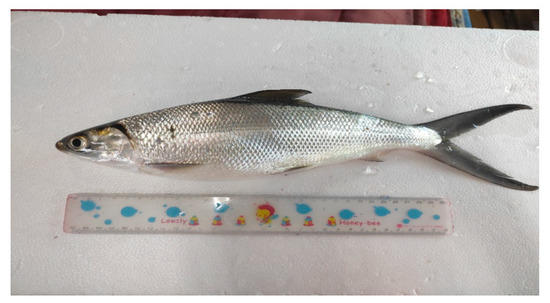
Figure 1.
The Milkfish (Chanos chanos) is 5 months, old; one tail is around 1.3 or 1.4 catty. Generally, Milkfish fry stocks at the size of 6 inches in February and March.
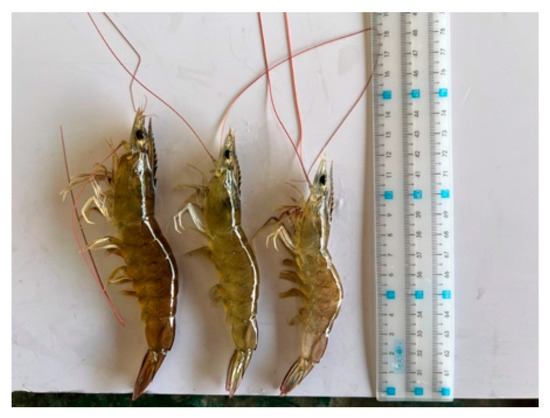
Figure 2.
From left to right, the weight of one white shrimp (Penaeus indicus) is 35, 43, and 55 per catty, respectively. The white shrimp are harvested at 156, 120, 105 days after stocking, respectively.
To date, Taiwan’s milkfish farming has been dominated by the inland farming style. From 2009 to 2018, the average inland farming area of milkfish was approximately 10,000 hectares per year, 28% of them was the inland farming system [7]. The average annual output was 55,000 metric tons, accounting for around 20%, the average annual output value was about NT$4 billion (US$134 million), accounting for about 12% [7]. We can say that milkfish is one of the most stable inland-cultured fish species in Taiwan. In terms of imports and export of milkfish from 2009 to 2018, most milkfish fry was imported from Indonesia, with an average annual import volume of 140 metric tons [7]. In contrast, the importing countries were Saudi Arabia, the United States, Canada, China, and Australia, with an average annual export volume of 9300 metric tons, accounting for about 17% of total production [7].
As milkfish is a tropical species, they are not resistant to low temperatures and reared at 28 °C. They will freeze to death in the low temperature in winter, such as cold snaps [8]. Taiwan often has cold snaps in winter, which is a major threat to its aquaculture and fisheries. In addition, given Taiwan’s long and narrow topography with a marine island-type climate, it has developed a boundary line along the Erren River in the south. Consequently, Taiwan has two different types of milkfish farming systems develops according to the characteristics of each geographical region (Figure 3). Above the line, most of the milkfish farming does not overwinter but under the line, most milkfish farming does. Hence, this paper aimed to distinguish between the two farming models: current year harvest and overwinter harvest. Both of them are cultivated alongside white shrimp to disperse risks and increase income.
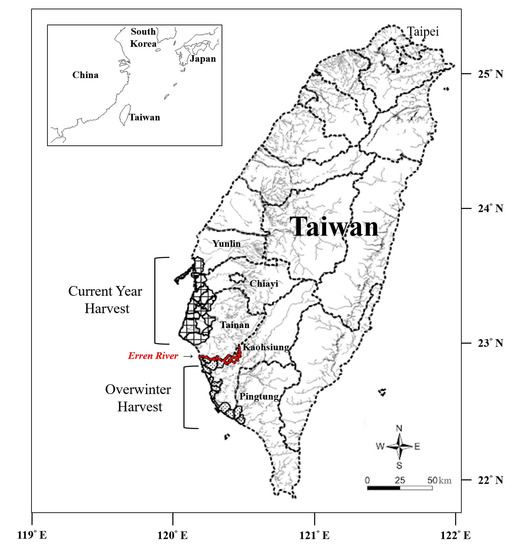
Figure 3.
Geographical locations of the milk fish farms in current year harvest and overwinter harvest, Taiwan.
Nowadays the harvest farming system, mainly located in the Yunlin, Chiayi and Tainan areas, is vulnerable to the northeast monsoon in winter and cold currents. Farmers must harvest before the temperature drops to avoid a population decline caused by low temperatures. Therefore, in the spring of each year, milkfish fry and white shrimp fry, at the minimum size of 2–8 inches, are gradually introduced into ponds. Milkfish in this current year system harvest are typically harvested from September to November before winter arrives. The harvest of white shrimp is usually started three months later after stocking; mainly from July to December. The harvest time for both is finished before the cold currents arrive. From 2009 to 2018, the average annual production of cultivated milkfish was about 36,000 metric tons, accounting for 66.5% of the total production [7].
Overwinter harvest farming is mainly distributed in the Kaohsiung and Pingtung areas, where the average temperature in winter is comparatively higher. Thus, the milkfish population is less likely declines due to low temperatures. In addition, due to its unique geographical characteristics, the lower quantity of overwintering milkfish yields results in higher market price. This system harvests intensively in autumn and winter, the average temperature is low, and the water quality is consistent. Then, the depth of the fish pond can reach to 3~4 m, and 20,000 fish fry can be raised per hectare. Because the milkfish and shrimp fry are mainly stocking in June, the milkfish intensively harvests from December to February and the farmers harvest the white shrimp from September to February in the following year. From 2009 to 2018, the average annual production of milkfish cultivated using the overwinter harvest system was about 18,000 metric tons, accounting for 32.7% of the total production [7].
In Taiwan, due to its island-type climate, more area adopts the current year harvest system. The results in low prices caused by high production. The average harvest price from 2014 to 2018 was NT$43 (US$1.44) per Taiwan catty [9]. In contrast, because only limited area can operate the overwinter harvest system less annual quantity of Taiwan catty causes price. The average harvest price is NT$49 (US$1.64) per Taiwan catty [9]. Although the price of the overwintering harvest is higher, the takes more time to harvest and costs more. Therefore, determining whether the technical efficiency and technological level of overwintering harvest farming are higher than those of current year farming is the main goal of this paper.
Some agricultural fishery literature has discussed its economic benefits [10,11,12], the efficiency of poly culturing Nile fish [13,14,15], shrimp [16,17], milkfish [3,18], perch, snapper [19] and clams [20], ways to evaluate the farming environment and farmers’ credit [21,22]. Ref. [18] used the traditional stochastic model to evaluate the production efficiency of milkfish. Without considering the differences between the farming environment and the production method, the results may be biased. Therefore, this paper divides production into the “current year harvest” and “overwinter harvest” models and applies the metafrontier production model proposed by [23]. This model modifies the lack of random error that [24,25] fail to take into account in the second stage of the metafrontier estimation model, which may lead to estimation error.
2. Model Specification
2.1. Theoretical Model
Generally, the previous literature has used nonparametric data envelopment analysis (DEA) for efficiency evaluation and parametric stochastic frontier analysis (SFA) to analyze, where SFA is in the form of a function and regression between the input and output is computed by assuming the production frontier and adding the combination error. However, this method regards all types of measurement units as one group and does not consider the differences between groups. Not until [24] put forward the metafrontier model was the metafrontier concept combined with stochastic frontier analysis to explore the technical differences between decision-making units in different groups. Figure 4 [23] illustrates the metafrontier production model. However, refs. [24,25] did not consider the impact of random errors on the stochastic frontier in the second stage. Ref. [23] put forward the latest two-stage stochastic frontier model to estimate the specific frontier and metafrontier of different groups, and used the stochastic frontier model to estimate the metafrontier model to solve the problem of the second stage metafrontier estimation method failing to consider random errors, which results in bias in the estimation results.
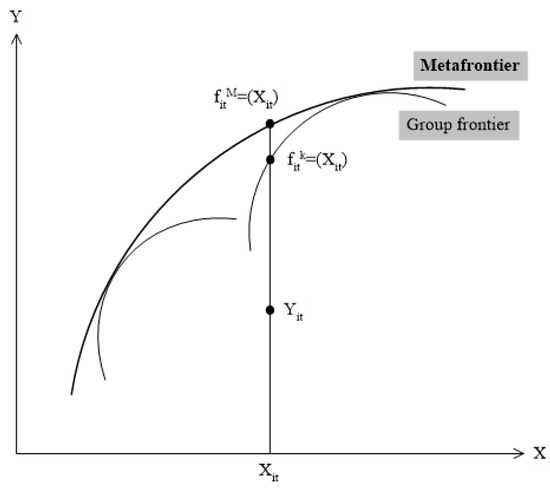
Figure 4.
Metafrontier production model by [23].
The section introduces the metafrontier and the distance functions, specification of the metafrontier framework for assessing efficiency. Our paper adopts the two-stage stochastic metafrontier method proposed by [23,26]. Recently, ref. [27] applied the same function to measure efficiency and productivity index of fossil fuel power plants in the U.S. We assume that there are k breeding area groups, the production technology level, is represented by the group k frontier, and the i-th breeding area input, xit, can produce the output, yit:
where xit and yit respectively denote the input and output vector of the ith firm in the kth group at the tth period. The setting can be extended to a metafrontier and can be written as:
Based on the definition of technical efficiency and the concepts proposed by [28], the distance function of group k condition on maximizing the output and minimizing the input can be written as:
The group technical efficiency (GTE) is measured by the kth group frontier. Likewise, we can be extended the distance function of the metafrontier can be defined as:
The metafrontier technical efficiency (MTE) measured by the metafrontier. The metafrontier by definition envelops all individual groups frontier . According to [23], the relationship between the group frontiers and metafrontier can be expressed as:
Hence, ≥ and the ratio of the kth group’s distance function to the metafrontier is defined as the technology gap ratio (TGR). According to the stochastic metafrontier model proposed by [23], in the first stage of estimating all individual groups frontier , environmental impact factors contributing to inefficiency are farmer managed related. In the second stage of estimating the metafrontier , the inefficiency factors are from the weather situation related.
2.2. Data Sources and Variables Definitions
In 2020, 170 farmers were interviewed in person by questionnaire to collect primary data on various items. 100 current year harvest farmers were sampled in the Yunlin, Jiayi and Tainan areas from 2018 to 2019 for the overwinter harvest system, 70 farmers in the Kaohsiung and Pingtung areas were sampled during the time from 2017 to 2018 and from 2018 to 2019. In addition, in order to reasonably evaluate the two farming systems, the relevant data were divided according to hectares per month, and the data were deflated using the wholesale price index as the base period for consistent comparison to eliminate the influence of the price index on the preliminary data.
According to the results of the Fishermen’s Economic Survey by the Taiwan Fisheries Agency, the highest cost associated with milkfish culturing is feed, which accounts for 39.7% of the total cost, followed by labor costs (13.9%), fish fry costs (10.9%), water, electricity and fuel costs (7.5%) and pond servicing costs (2.9%). Referring to the variable settings in studies such as [3], this paper takes four input variables, namely, labor cost, fry cost, feed cost and water, electricity and miscellaneous cost, and two output variables, namely, milkfish production and white shrimp production. The input and output data are converted to the monthly, per-hectare average to be used as the evaluation benchmark. In terms of input variables, labor cost (x1) refers to the salary paid to self-employed workers and employees; fry cost (x2) refers to the cost of purchasing milkfish fry and shrimp fry of different sizes; feed cost (x3) refers to the cost of purchasing feed; water, electricity and miscellaneous cost (x4) refers to the total of water, electricity, land preparation, medicine, repair, network work and depreciation. The output variables are the output of milkfish (y1) and white shrimp yield (y2). Table 1 shows that the overwintering harvest model is statistically significantly higher than the current year harvest model in terms of labor cost, feed cost, and milkfish production due to its use of deep ponds and high-density stocking; the water, electricity, and miscellaneous cost of the current year harvest model is significantly higher than that of the overwinter harvest model due to the increased costs associated with the summer tariff policy; its white shrimp yield is also significantly higher than that of the overwinter harvest. In brief, the input and output of the two different culturing models may be either high or low, so it is difficult to directly see the advantages and disadvantages of the technical efficiency of each from the data alone.

Table 1.
Descriptive statistics on inputs, outputs and environment variables and t test. on the difference between groups.
The milkfish farming is strongly influenced by the environment. Therefore, we follow [20] in setting the environmental variables. Based on the stochastic metafrontier model, environmental impact factors faced by each mode set for the first stage for the two different culturing models are the pond depth (z1), fish fry size (z2), milkfish density (z3) and white shrimp density (z4); for the second stage, the external environmental impact factors commonly faced by the two different models are the minimum temperature (z5) and average rainfall (z6), respectively. Table 1 shows that in the first stage, the overwintering harvest model is significantly higher than the current year harvest model in terms of pond depth and cultivation density because it requires a deep pond for smooth overwintering. However, because the current year harvest model must avoid overwinter, the size of fish fry is significantly larger than that in the overwintering harvest model. In the second stage, the lowest temperature of the current year harvest model without overwintering is significantly higher than that in the overwintering harvest model, but the average rainfall is the opposite. For the relationship between the above environmental variables and technical inefficiency, the expected minimum temperature (z5) is significantly negatively correlated with the inefficiency. The other five environmental variables are expected to be positively correlated with inefficiency.
2.3. Empirical Model
We use the input distance function model proposed by [29]. Based on SFA and the translog input distance function meets the first-order homogeneous parameter conditions by [27,28]. We imposed homogeneity of degree of 1 upon the function model. Therefore, the stochastic distance function model for the kth group’s input is specified as follows:
According to [30], where Vt~N(0, σV2) are random estimation error which are independent normal distributed. The error represents the deviation of input or output from the frontier. Hence, Ut~N(mt, σU2) are random variables to account for technical inefficiency in production frontier and independent normal distributed. Therefore, mt = Ztß where Z is environment variables which may influence the inefficiency and ß is the parameters coefficient.
Therefore, the stochastic metafrontier for the input distance function model by [23] can be written as:
The traditional SFA model of production is limited to analyzing single output. This paper synchronously expands it into a distance function to measure multi-input-multi-output production technology, which refers to the input-driven distance function that pursues the minimum input given a fixed level of output [31]. In this way, it can more clearly describe the impact of environmental variables on production technology.
3. Empirical Analysis
3.1. Descriptive Statistics and Parameter Estimation Results
Table 2 shows the results of the parameter estimates for the current year harvest frontier, the overwintering harvest frontier, and both culturing modes’ metafrontier. In these models, more than half of the variables reach the statistical significance level. In the first stage, on the inefficiency variables affecting the current year and the overwintering harvest models, the pond depth (z1), size of the fry (z2) and density of shrimp (z4) reached positive significant levels in both cultivation models. The results indicated that the deeper the pond, the larger the size of the fry and the higher the density of white shrimp are, the significantly greater the inefficiency is. The results mean that stocking will increase when the pond is deeper, resulting in low survival rates at low pond levels and possible feed waste. Larger fry sizes will also increase purchase costs. The white shrimp harvest can easily be affected by weather, resulting in poor yield. The above results are also consistent with the results in the existing literature. In the metafrontier inefficiency model of the second stage, the minimum temperature (z5) reaches a negative significant level. That indicated milkfish may freeze to death or grow slowly in low temperatures. Hence financial losses were expected.

Table 2.
Stochastic frontier parameter estimation results.
3.2. GTE, MTE and TGR
By using the coefficient estimates in Table 2, we can estimate the group technical efficiency (GTE) of the two different culturing models as each is separately assessed, and the metafrontier technical efficiency (MTE) based on an assessment of both. Consequently, the technology gap rate (TGR) can be derived by dividing the two. It can be seen from Table 3 that the GTE of the current year harvest model is 0.7892. It means that using the current input-output and considering the influence of the environmental variables, the technical efficiency reaches 78.92%, which means that efficiency can still be improved by 21.08%. Thus, input should continue to be reduced and output increased to improve technical efficiency. We should reduce the input and increase the output to improve technical efficiency. The Tainan area has the highest technical efficiency, followed by Jiayi and Yunlin. Through the nonparametric Mann–Whitney U Test, it can be seen that there are significant differences in GTE among the three areas. The overwintering harvest GTE is 0.8629 (86.29%), leaving room for 13.71% efficiency improvement. However, there is no significant difference between the results from the two areas. The distribution of the technical efficiency of the two culturing models is shown in Figure 5 and Figure 6. The technical efficiency of the above two groups refers to the comparison of the relative efficiency within their respective groups. Therefore, only the statistical verification of the differences within the groups can be carried out-not between the two groups. The cross-group or cross-area efficiency verification can only be conducted based on the results of the overall relative comparison in the following section.

Table 3.
Non-parametric test for group technical efficiency (GTE), metafrontier technical efficiency (MTE), and technical gap rate (TGR) between two groups.
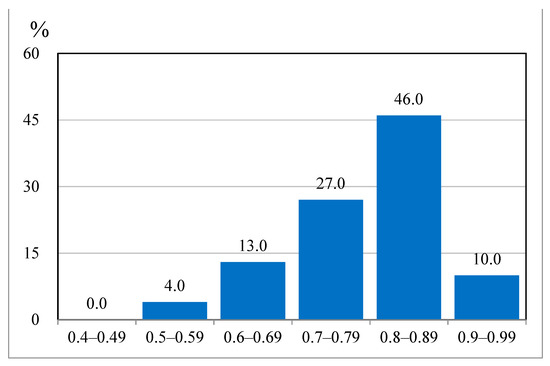
Figure 5.
Distribution of group technical efficiency (GTE) scores of Current Year Harvest.
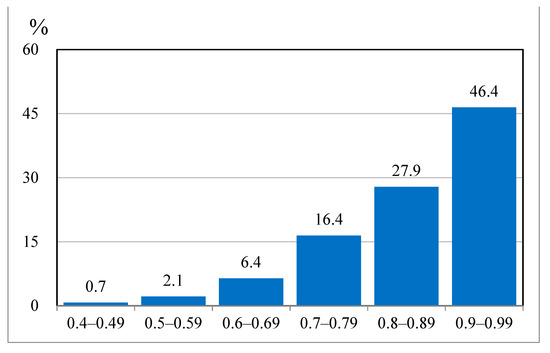
Figure 6.
Distribution of group technical efficiency (GTE) scores of Overwinter Harvest.
Metafrontier technical efficiency (MTE) refers to the efficiency measurement of all farmers in both culturing models while considering the impact of environmental differences. It also refers to the ratio of the actual production level of different farmers to the production level on the metafrontier. The numerical calculation results of the metafrontier coefficient in Table 3 shows that the overall average MTE is 0.6408 (Figure 7). This implies that only 64.08% of the potential technical efficiency is achieved based on the current input-output combination and accounting for the differences in environmental factors, which leaves 35.92% improvement potential. Thus, work must be done to reduce input costs and increase output to improve overall technical efficiency. According to the verification results (Table 3), the MTE value of the current year harvest model is 0.6539, which is significantly higher than the 0.6222 value of the overwintering harvest model. Consistent with the GTE results, the Tainan area is still the highest (0.6757) of the three areas under the current year harvest model, followed by Jiayi and Yunlin. Thus, it indicates that Yunlin has the greatest room for efficiency improvement. There are significant differences in the MTE values between the three areas.
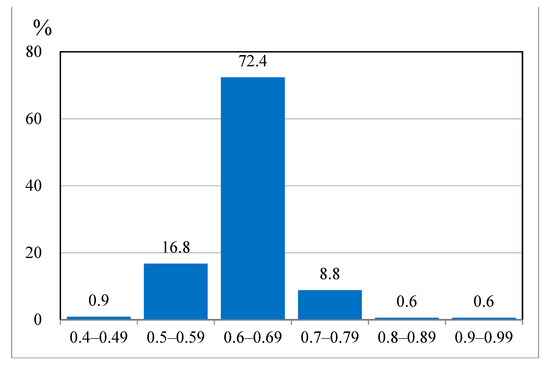
Figure 7.
Distribution of metafrontier technical efficiency (MTE) scores.
The technology gap rate (TGR) is the MTE obtained from all methods taken together divided by the GTE of different methods. A TGR of 1 implies that farmers’ production technology is better when both the individual GTE and the MTE of all methods together are consistent. Table 3 shows that the average TGR is 0.7913 (Figure 8), thus it indicates that the current production technology of all methods is 79.13%. That means the current production technology can be improved by 20.87% by either reducing input or increasing output. The verification results show that the GTR of the current year harvest model is 0.8344, which is significantly higher than the 0.7297 value of the overwintering harvest model. Then, it indicates that the latter has significantly more room for improvement in terms of production technology. From the perspectives of the two areas, all reach a significant level, with Yunlin being the highest for the current year harvest model, followed by Jiayi and Tainan. Tainan performs relatively well in both GTE and MTE, although the efficiency gap between the two is relatively large, which results in a low TGR and indicates that Tainan has more room for improvement in terms of production technology. The winter harvest pattern in Pingtung was significantly higher than that in Kaohsiung.
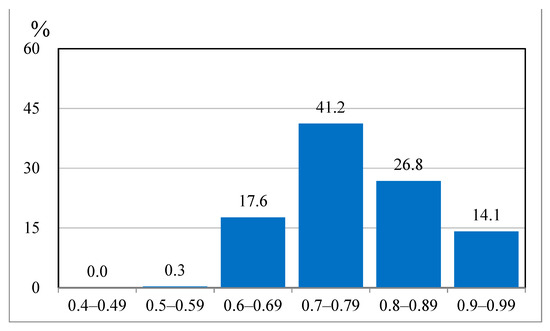
Figure 8.
Distribution of the technical gap rate (TGR) scores.
3.3. Regression Analysis
A regression analysis was conducted to explore the impact of the farmers’ personal experience and the characteristics of the farming area on MTE and TGR. Table 4 shows that for MTE, the younger the farmer’s age, the lower the farmer’s educational background, the larger the cultivating area, and the more years of cultivation experience-as well as experience in freshwater farming-generate relative better MTE results. It suggests that young farmers are willing to accept new knowledge and justify their practices. Farmers with less education are more likely to embrace new knowledge with an open Large-scale scale cultivation can effectively reduce the cost of manpower, feed, and fry. The more the years of fish cultivation the farmer has, the more experience will be accumulated, thus making it possible to timely adjust the dissolved oxygen in the pond according to the climate and decide the optimal input of feed, so as to reduce the unnecessary input cost. In freshwater aquaculture, fish do not need to consume energy to remove salt to create a low salinity environment, which is conducive to physical growth. The analysis of TGR shows that the higher the farmers’ education, the lower their pond age, and the longer their cultivating experience in farming, plus freshwater, the relatively better their production technology is. This suggests that the higher the level of their education, the more ability they have to use their learned knowledge to invest in the orderly management of their cultivating field. The younger the pond age, the better the pond environment is, and the greater the experience, the better the accumulation of technology is, which helps to control costs.

Table 4.
Regression results on the metafrontier technical efficiency (MTE) and technical gap rate (TGR).
4. Discussion
This paper evaluated the production efficiency of Taiwan’s Milkfish in different culturing models by using the stochastic metafrontier production model proposed by [23]. This prior study modified the models of [24,25], added environmental variables to the model and used the new stochastic frontier analysis to evaluate the technical efficiency and production technology for firms in different groups. A regression analysis was conducted to explore the impact of surveyed farmers’ personal experience and the characteristics of the farming area on the metafrontier technical efficiency (MTE) and technical gap rate (TGR).
This paper shows that in spite of the environmental difference between two culturing models, shallower ponds, smaller size of fish fry, and lower shrimp density should make culturing more technically efficient. Prior research [13] considers the flexible risk properties and uses the stochastic frontier model to analyze production risk, technical efficiency and determinants of fish farms in four regions of Ghana. Their result found production risks exist in fish farms [13]. Other researchers [20] analyzed the efficiency of hard clam (Meretrix meretrix) farmer polyculture with milkfish (Chanos chanos), silver sea bream (Rhabdosargus sarba), and shrimps at different hard clam stocking densities in Taiwan. Here, farmers were found to have to consider product-specific economies of scope at various levels of production [20]. We had similar results as [13,20], where environmental variables were key determinants of technological efficiency for groups.
Our analysis revealed that age, had a statistically negative significant effect on technology efficiency. Our results were similar to the findings of [32,33,34,35], which established that young farmers are willing to accept new knowledge, invest in technology development and adoption and justify their practices. Another prior study [36] proposed that in order to gain beneficial experience for young farmers, they should be trained in farm production supervision and management.
We found the coefficient of education to have a positive and statistically significant impact on technology efficiency. With the improvement of farmers’ education level, the impact of education on technical efficiency was similarly found to be significant by prior studies [13,37,38,39,40]. The reason was more educated farmers have better skills, access to information and better farm management. The higher education, the more ability to use their knowledge to invest in the orderly management of cultivating their field. However, see [18,33] who found that education level had a significant negative effect on technical efficiency. While high levels of academic education may not necessarily be helpful to farmers, the type of formal training (e.g., fish farming) may be useful [33].
Our analysis revealed that production area had a statistically positive significant effect on technology efficiency. Similarly, larger pond size contributed to greater efficiency [13,17,41,42,43], and farmers with an open large-scale scale cultivation can effectively reduce the cost of labor. A prior study [36] proposed that large ponds have cost advantages and farmers can adopt new technologies and facilities. The analysis revealed that fish farming years had a statistically positive significant effect on technology efficiency. The more the years of fish cultivation the farmer has, the more experience will be accumulated, thus making it possible to timely adjust the dissolved oxygen in the pond according to the climate and decide the optimal input of feed, so as to reduce unnecessary input costs. Highly experienced farmers had more technical efficiency [44,45] because they have stronger managerial ability [46], extensive connections with workers and suppliers [34], and attendance at workshops [35]. Similar results were found in other studies such as [47,48].
There are certain limitations to our study. First, future research needs to increase the sample size of surveyed farmers. We only surveyed 100 current year and 70 overwinter harvest farmers from 2017 to 2019. Secondly, our research explores the impact of farmers’ personal experience and the characteristics of the farming area on MTE and TGR using only seven variables. Future research should consider adding more factors that affect technical efficiency, such as cultivation skills, government policy, and pond tenure.
5. Conclusions
This paper takes into consideration the differences between both the culturing models and climates with the application of the metafrontier production model proposed by [1] and extended to the multi-input-multi-output distance function form, calculated the group technical efficiency (GTE), the metafrontier technical efficiency (MTE) and technical gap rate (TGR), and reasonably evaluated the technological efficiency and production technology of two different culturing models. Our empirical result found that the MTE and TGR of the current year harvest model were significantly higher than those of the overwintering harvest model after considering the differences between the two culturing models and their internal and external environments. This indicates that the technical efficiency and production technology used in the current year harvest model were superior to those of the overwinter harvest model. It also shows that the overwinter harvest model had a longer cultivation period. Therefore, despite its high output, it also required high input and, as a result, its technical efficiency and production technology were inferior to those of the current year harvest model. On the whole, under the current input-output combination, its technical inefficiency can be improved by 35.92% and its production technology by 20.87%. Therefore, efforts should be made to reduce input costs and increase output to improve the technical efficiency and production technology of polyculture. The regression analysis suggests that the younger the farmers, the lower their educational background, the longer their cultivation experience, cultivation area, and longer their experience with freshwater farming, the relatively better MTE values are for farmers. When farmers have higher education, newer ponds, and more cultivation experience in freshwater farming, the level of production technology is relatively better.
Author Contributions
Conceptualization, Y.-H.L. and J.-J.L.; methodology, Y.-H.L. and Y.-W.H.; software, Y.-H.L. and Y.-W.H.; validation, Y.-H.L., J.-J.L. and S.-J.H.; formal analysis, Y.-H.L. and Y.-W.H.; investigation, Y.-H.L. and Y.-W.H.; resources, Y.-H.L. and J.-J.L.; data curation, Y.-H.L.; writing—original draft preparation, J.-J.L. and S.-J.H.; writing—review and editing, J.-J.L. and S.-J.H.; supervision, Y.-H.L. and J.-J.L.; project administration, J.-J.L. and S.-J.H.; funding acquisition, Y.-H.L., J.-J.L. and S.-J.H. All authors have read and agreed to the published version of the manuscript.
Funding
This research received no any external funding.
Data Availability Statement
This study data are available on request from the author’s. The data are not publicly due to privacy or ethical restrictions.
Acknowledgments
The authors are thankful to farming household for providing the data.
Conflicts of Interest
The author’s no conflict of interest.
References
- Mangampa, M.; Burhanuddin, B. Field experiment of polyculture technology of tiger shrimp (P. monodon Farb.) Milkfish (Chanos chanos Forskal), and Seaweed (Gracilaria verrucosa) in Brackhiswater water pond of Borimasunggu village, Maros regency. Saintek Perikan. Indones. J. Fish. Sci. Technol. 2014, 10, 30–36. [Google Scholar] [CrossRef]
- Helminuddin, P.E.; Abdusysyahid, S. A Marketing and Financial Analysis of Milkfish (Chanos chanos) and Giant Tiger Prawn (Penaeus monodon) Farming in East Kalimantan. Int. J. Innov. Creat. Chang. 2020, 11, 581–591. Available online: https://www.ijicc.net/images/vol11iss4/11446_Helminuddin_2020_E_R.pdf (accessed on 26 August 2022).
- Lee, Y.C.; Lu, Y.H.; Lee, J.M.; Schafferer, C.; Yeh, C.Y.; Chu, T.W.; Huang, Y.W. A production economic analysis of different stocking density and fry size combinations of milkfish, Chanos chanos, farming in Taiwan. J. World Aquac. Soc. 2022, 53, 424–451. [Google Scholar] [CrossRef]
- Pai, W.T.; Schafferer, C.; Lee, J.M.; Ho, L.M.; Lu, Y.H.; Yang, H.C.; Yeh, C.Y. Effect of Culture Period and Stocking Density on Input Demand and Scale Economies ofMilkfish (Chanos chanos) Polycultures withWhite Shrimp (Penaeus indicus). Fishes 2022, 7, 110. [Google Scholar] [CrossRef]
- Jaspe, C.J.; Caipang, C.M.A.; Elle, B.J.G. Polyculture of white shrimp, Litopenaeus vannamei and milkfish, Chanos chanos as a strategy for efficient utilization of natural food production in ponds. Anim. Biol. Anim. Husb. 2011, 3, 96–104. Available online: http://www.abah.bioflux.com.ro/docs/2011.3.96-104.pdf (accessed on 26 August 2022).
- Lalramchhani, C.; Balasubramanian, C.P.; Panigrahi, A.; Ghoshal, T.K.; Das, S.; Shyne Anand, P.S.; Vijayan, K.K. Polyculture of Indian white shrimp (Penaeus indicus) with milkfish (Chanos chanos) and its effect on growth performances, water quality and microbial load in brackish water pond. J. Coast. Res. 2019, 86, 43–48. [Google Scholar] [CrossRef]
- Fisheries Agency, Council of Agriculture, Ececutive Yuan. Fisherise Statistical Yearbook; Taiwan, Kinmen and Matsu Area. 2009–2018. Available online: https://www.fa.gov.tw/list.php?theme=FS_AR&subtheme= (accessed on 26 August 2022).
- Chang, C.H.; Mayer, M.; Georgina, R.I.; Eva, B.B.; Wu, W.Y.; Catherine, L.N.; Lee, T.H. Effects of temperature and salinity on antioxidant responses in livers of temperate (Dicentrarchus labrax) and tropical (Chanos Chanos) marine euryhaline fish. J. Therm. Biol. 2021, 99, 103016. [Google Scholar] [CrossRef] [PubMed]
- Fisheries Agency, Council of Agriculture, Ececutive Yuan. Global Information Network for Fishery; 2014–2018. Available online: https://efish.fa.gov.tw/ (accessed on 26 August 2022).
- Sharma, K.R.; Leung, P. Technical efficiency of carp production in Nepal: An application of stochastic frontier production function approach. Aquac. Econ. Manag. 1998, 2, 129–140. [Google Scholar] [CrossRef]
- Iinuma, M.; Sharma, K.R.; Leung, P.S. Technical efficiency of carp pond culture in peninsula Malaysia: An application of stochastic production frontier and technical inefficiency model. Aquaculture 1999, 175, 199–213. [Google Scholar] [CrossRef]
- Sharma, K.R. Technical efficiency of carp production in Pakistan. Aquac. Econ. Manag. 1999, 3, 131–141. [Google Scholar] [CrossRef]
- Onumah, E.E.; Onumah, J.A.; Onumah, G.E. Production risk and technical efficiency of fish farms in Ghana. Aquaculture 2018, 495, 55–61. [Google Scholar] [CrossRef]
- Rahman, M.T.; Nielsen, R.; Khan, M.A.; Asmild, M. Efficiency and production environmental heterogeneity in aquaculture: A meta-frontier DEA approach. Aquaculture 2019, 509, 140–148. [Google Scholar] [CrossRef]
- Dey, M.M.; Paraguas, F.J.; Bimbao, G.B.; Regaspi, P.B. Technical efficiency of tilapia growout pond operations in the Philippines. Aquac. Econ. Manag. 2000, 4, 33–47. [Google Scholar] [CrossRef]
- Kumaran, M.; Anand, P.R.; Kumar, J.A.; Ravisankar, T.; Paul, J.; Vasagam, K.P.K.; Vimala, D.D.; Raja, K.A. Is Pacific white shrimp (Penaeus vannamei) farming in India is technically efficient?–A comprehensive study. Aquaculture 2017, 468, 262–270. [Google Scholar] [CrossRef]
- Long, L.K.; Thap, L.V.; Hoai, N.T. An application of data envelopment analysis with the double bootstrapping technique to analyze cost and technical efficiency in aquaculture: Do credit constraints matter? Aquaculture 2020, 525, 735290. [Google Scholar] [CrossRef]
- Chiang, F.S.; Sun, C.H.; Yu, J.M. Technical efficiency analysis of milkfish (Chanos chanos) production in Taiwan-an application of the stochastic frontier production function. Aquaculture 2004, 230, 99–116. [Google Scholar] [CrossRef]
- Karagiannis, G.; Katranidis, S.D.; Tzouvelekas, V. Measuring technical, allocative and cost efficiencies of seabass and seabream farms in Greece. Aquac. Econ. Manag. 2000, 4, 191–207. [Google Scholar] [CrossRef]
- Yeh, C.Y.; Huang, J.F.; Lee, J.M.; Schafferer, C. An economic analysis of hard clam (Meretrix meretrix) farmer polyculture with milkfish (Chanos chanos), silver sea bream (Rhabdosargus sarba), and shrimps at different hard clam stocking densities: A case study of Yunlin County, Taiwan. Aquac. Int. 2017, 25, 1039–1055. [Google Scholar] [CrossRef]
- Bayazid, Y.; Umetsu, C.; Hamasaki, H.; Miyanishi, T. Measuring the efficiency of collective floodplain aquaculture of Bangladesh using Data Envelopment Analysis. Aquaculture 2019, 503, 537–549. [Google Scholar] [CrossRef]
- Hai, A.T.N.; Speelman, S. Economic-environmental trade-offs in marine aquaculture: The case of lobster farming in Vietnam. Aquaculture 2020, 516, 734593. [Google Scholar] [CrossRef]
- Huang, C.J.; Huang, T.H.; Liu, N.H. A new approach to estimating the metafrontier production function based on a stochastic frontier framework. J. Prod. Anal. 2014, 42, 241–254. [Google Scholar] [CrossRef]
- Battese, G.E.; Rao, D.S.P.; O’Donnell, C.J. A metafrontier production function for estimation of technical efficiencies and technology gaps for firms operating under different technologies. J. Product. Anal. 2004, 21, 91–103. [Google Scholar] [CrossRef]
- O’Donnell, C.J.; Rao, D.S.P.; Battese, G.E. Metafrontier frameworks for the study of firm-level efficiencies and technology ratios. Empir. Econ. 2008, 34, 231–255. [Google Scholar] [CrossRef]
- Huang, T.H.; Chiang, D.L.; Tsai, C.M. Applying the new metafrontier directional distance function to compare banking efficiencies in Central and Eastern European countries. Econ. Model. 2015, 44, 188–199. [Google Scholar] [CrossRef]
- Lu, Y.H.; Chen, K.H.; Cheng, J.C.; Chen, C.C.; Li, S.Y. Analysis of Environmental Productivity on Fossil Fuel Power Plants in the U.S. Sustainability 2019, 11, 6907. [Google Scholar] [CrossRef]
- Cuesta, R.A.; Lovell, C.A.K.; Zofío, J.L. Environmental efficiency measurement with translog distance functions: A parametric approach. Ecol. Econ. 2009, 68, 2232–2242. [Google Scholar] [CrossRef]
- Färe, R.; Primont, D. Multi-Output Production and Duality: Theory and Applications; Kluwer Academic Publishers: Boston, MA, USA, 1995. [Google Scholar]
- Battese, G.E.; Coelli, T.J. A model for technical inefficiency effects in a stochastic frontier production function for panel data. Empir. Econ. 1995, 20, 325–332. [Google Scholar] [CrossRef]
- Shephard, R.W. Theory of Cost and Production Functions; Princeton University Press: Princeton, NJ, USA, 1970. [Google Scholar]
- Ekunwe, P.A.; Emokaro, C.O. Technical efficiency of catfish farmers in Kaduna, Nigeria. J. Appl. Sci. Res. 2009, 5, 802–805. [Google Scholar]
- Onumah, E.E.; Brümmer, B.; Hörstgen-Schwark, G. Elements which delimitate technical efficiency of fish farms in Ghana. J. World Aquacult. Soc. 2010, 41, 506–518. [Google Scholar] [CrossRef]
- Iliyasu, A.; Mohamed, Z.A. Evaluating contextual factors affecting the technical efficiency of freshwater pond culture systems in peninsular Malaysia: A two-stage DEA approach. Aquac. Rep. 2016, 3, 12–17. [Google Scholar] [CrossRef][Green Version]
- Iliyasu, A.; Mohamed, Z.A.; Terano, R. Comparative analysis of technical efficiency for different production culture systems and species of freshwater aquaculture in peninsular Malaysia. Aquacult. Rep. 2016, 3, 51–57. [Google Scholar] [CrossRef]
- See, K.F.; Ibrahim, R.A.; Goh, K.H. Aquaculture efficiency and productivity: A comprehensive review and bibliometric analysis. Aquaculture 2021, 544, 736881. [Google Scholar] [CrossRef]
- Begum, M.; Hossain, M.I.; Papanagiotou, E. Technical efficiency of shrimp farming in Bangladesh: An application of the stochastic production frontier approach. J. World Aquacult. Soc. 2013, 44, 641–654. [Google Scholar] [CrossRef]
- Tsue, P.T.; Lawal, W.L.; Ayuba, V.O. Productivity and technical efficiency of catfish farmers in Benue State: Nigeria. Adv. J. Agric. Res. 2013, 1, 20–25. [Google Scholar]
- Oluwatayo, I.B.; Adedeji, T.A. Comparative analysis of technical efficiency of catfish farms using different technologies in Lagos State, Nigeria: A Data Envelopment Analysis (DEA) approach. Agric. Food Secur. 2019, 8, 8. [Google Scholar] [CrossRef]
- Nyamuhirwa, D.M.A.; Awotide, B.A.; Kusinza, D.B.; Bishikwabo, V.K.; Mignouna, J.; Bamba, Z.; Nguezet, P.M.D. A Comparative Analysis of Technical Efficiency and Profitability of Agribusiness and Non-Agribusiness Enterprises in Eastern DRC. Sustainability 2022, 14, 8384. [Google Scholar] [CrossRef]
- Dey, M.M.; Paraguas, F.J.; Srichantuk, N.; Xinhua, Y.; Bhatta, R.; Thi Chau Dung, L. Technical efficiency of freshwater pond polyculture production in selected Asian countries: Estimation and implication. Aquac. Econ. Manag. 2005, 9, 39–63. [Google Scholar] [CrossRef]
- Roy, A.K.; Jens, N. Econometric approach for estimation of technical efficiency of aquaculture farms. In Applied Bioinformatics, Statistics and Economics in Fisheries Research; Roy, A.K., Serangi, N., Eds.; New India Publishing Agency: New Delhi, India, 2008; pp. 501–518. [Google Scholar]
- Iliyasu, A.; Mohamed, Z.A.; Hashim, M. Productivity growth, technical change and efficiency change of the Malaysian cage fish farming: An application of malmquist productivity index approach. Aquac. Int. 2015, 23, 1013–1024. [Google Scholar] [CrossRef]
- Cinemre, H.; Ceyhan, V.; Bozoğlu, M.; Demiryürek, K.; Kılıç, O. The costefficiency of trout farms in the Black Sea Region, Turkey. Aquaculture 2006, 251, 324–332. [Google Scholar] [CrossRef]
- Kareem, R.O.; Dipeolu, A.O.; Aromolaran, A.B.; Samson, A. Analysis of technical, allocative and economic efficiency of different pond systems in Ogunstate, Nigeria. Afr. J. Agric. Res. 2008, 3, 246–254. [Google Scholar]
- Kaliba, A.R.; Engle, C.R. Productive efficiency of catfish farms in Chicot county, Arkansas. Aquac. Econ. Manag. 2006, 10, 223–243. [Google Scholar] [CrossRef]
- Kareem, R.O.; Aromolaran, A.B.; Dipeolu, A.O. Economic efficiency of fish farmingin Ogun state, Nigeria. Aquac. Econ. Manag. 2009, 13, 39–52. [Google Scholar] [CrossRef]
- Irz, X.; Mckenzie, V. Profitability and technical efficiency of aquaculturesystems in pampaanga, philippines. Aquacult. Econ. Manag. 2003, 7, 195–211. [Google Scholar] [CrossRef]
Publisher’s Note: MDPI stays neutral with regard to jurisdictional claims in published maps and institutional affiliations. |
© 2022 by the authors. Licensee MDPI, Basel, Switzerland. This article is an open access article distributed under the terms and conditions of the Creative Commons Attribution (CC BY) license (https://creativecommons.org/licenses/by/4.0/).